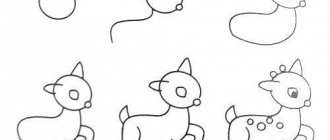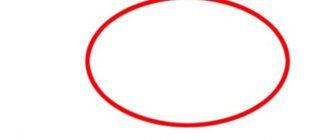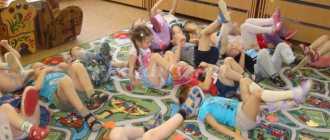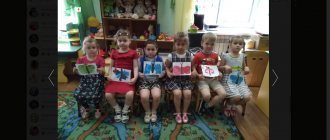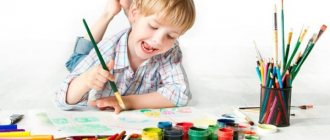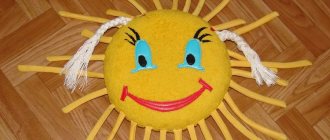GCD for non-traditional drawing in the middle group Topic: “Winter's Tale”
Transcript
1 GCD on non-traditional drawing in the middle group Topic: “Winter's Tale” Direction: artistic and aesthetic Goal: to master the methods of drawing with a thread Objectives: to develop interest in non-traditional images on paper. Educational: arouse children's interest in winter natural phenomena, develop the ability to draw with a thread, and develop a sense of composition. Developmental: develop fine motor skills of the hand, visual observation, imagination and imagination of the child. Educational: to cultivate neatness while working. Progress of GCD 1. Organizational moment: Children sit on chairs, the Snow Maiden enters to the music. Snow Maiden: The white blizzard is spinning and spreading, Covering the stitches and bridges with whiteness. Along the alley I walk Snow Maiden. From the fairy-tale mansion I appeared. -Hello guys! By the time I got to you, I was frozen! Were you cold when you went to kindergarten today? - Why, what time of year is it now? — Is the weather outside consistent with autumn? Children's answers: - Why did you decide that it was winter? Children's answers: Snow Maiden: - Children (I ask the child), what can you call the weather when snow falls? Is there a strong wind blowing and snow swirling in the air? (blizzard, blizzard, blizzard) - Guys, I have a surprise for you - an excerpt from the cartoon “The Snow Queen”, where you will see how a blizzard blows and a blizzard sweeps. (Guys, pay attention to how the blizzard draws patterns) (showing a cartoon) - Children, can you repeat the blizzard song? “Uuuuuuuuuuuuuuuuuuuuuuuuuuuuuuuuuuuuuuuuuuuuuuuuuuuuuuuuuuuu” - How does a snowstorm blow? “Sh-sh-sh-” Children, what a great fellow you are, the blizzard and blizzard turned out well for you. Music (I'm telling a fairy tale) Do you like fairy tales? Listen to one fairy tale. Once upon a time there lived a grandmother Vyuga, she had a beautiful winter shawl decorated with snowflakes. (show). At night, snowflakes rested on Grandma Vyuga’s shawl. When Grandmother Vyuga woke up, she took her shawl and shook it, then the snowflakes flew apart in a dance. (Shaking the shawl) - Why do you think the snowflakes scattered? -What are they?
2 Guys, all the snowflakes scattered, and Grandma Vyuga’s shawl was left without patterns. And not at all as beautiful as she was. What should we do now? You and I, too, can turn into snowflakes. 2. Physical education is held (to music) We are white snowflakes, flying, flying, flying! We'll cover the paths and paths with snow. Let's circle over the garden on a cold winter day, And sit quietly next to people like us! Snow Maiden: come up and place Grandma Vyuga’s snowflakes on the shawl. Well done guys, they helped Grandma Vyuga. Snow Maiden: Children, you told me that winter will come soon! — What long-awaited, beloved holiday is approaching? Children's answers - Who is the main character at the New Year's party? Voice of Grandmother Vyuga: -Guys! Help me please! The holiday is approaching. And in our forest the animals have nothing to decorate the New Year tree with. Help me please! Snow Maiden: Shall we help Grandmother Vyuga? Then come to the table. Whose birthday did we celebrate last week? Who came to visit us? And so he left snowflakes, and on the snowflakes we will draw winter patterns, and not simple patterns, but with the help of magic threads. 3. Preparation for the activity process Before we start drawing, we need to stretch our fingers. 4. A finger game is being played. Our fingers can do everything, they can do everything, they can help everyone. Fingers can draw, you just need to stretch them. Finger pads - draw cheesecakes. Our fists draw pies. (they clap their fists on their palms) And we draw palms, (they move their palms up and down) The drawings are simply top class! (show thumb) 5. The process of the Snow Maiden’s activity: Guys, take the thread by the knot and, without letting go, dip it into the paint, and you choose the paint yourself, the one you like best, take it out, shake the extra drops and draw a pattern on the snowflake, then cover it with a clean piece of paper , pressing lightly with your palm. And while you are holding the leaves with your palms, I will say the magic words: “Lie down, soft snows, on the forests and meadows, Cover the paths, feather the branches Easy knowledge, cunning plexus.”
3 (Children draw to the music) - what patterns did you get? (beautiful, fabulous) You are all just great! Guys, let's decorate our Christmas tree with them and let everyone see what snowflakes we made! Do you like it? (children decorate the Christmas tree). Recording of Vyuga's voice. (Music sounds) Thank you! Guys! You fulfilled my request, you made charming snowflakes, I really liked them and are looking forward to seeing them in our forest. - Children, how are we going to send them to the forest? Children Okay, we will do this, you can pass it on to me. Snow Maiden: Guys, Grandma Vyuga was pleased with your drawings. And I really liked your work, but it’s time for me to say goodbye to you. Thank you! Goodbye!!! Until next time.
4 Self-analysis Direct educational activities on artistic and aesthetic development. Topic: "Winter's Tale". The abstract was developed in accordance with the program of artistic education, training and development of children 2-7 years old “Colored Palms” by I.A. Lykova, I used the teaching aids “Drawing without Brushes” by I.A. Lykova. Why an unconventional drawing method, because its use helps children feel more relaxed, bolder, more spontaneous, develops imagination, and gives complete freedom for self-expression. In addition, work contributes to the development of coordination of movements. The child loves to quickly achieve results in his work, and unconventional techniques contribute to this. The lesson is complex, combines educational areas: cognitive development, speech development, social and communicative development, artistic and aesthetic development, physical development, which corresponds to the age and psychological characteristics of children in the middle group. Taking all this into account, I set a goal: to master an unconventional method of drawing with threads. When planning the GCD, I set the following tasks: Educational: to develop the ability to draw with gouache using an unconventional technique - strings. Developmental: develop fine motor skills of the hand, visual observation, imagination and imagination of the child. Educational: cultivate positive motivation, accuracy during work, promote active interaction between children and the teacher. Included the integration of educational areas: “Speech development”: development of an active vocabulary on the topic, development of free communication with adults and children, pronunciation of the sounds “U”, “W”. “Cognitive development”: consolidate the ability to navigate on a sheet of paper. “Physical development”: physical education, finger game “Our fingers can do anything.” “Social-communicative”: the formation of friendly relationships between children. “Artistic and aesthetic development”: drawing with threads. To achieve the set goals, the following structure was used: 1st organizational stage provided psychological preparation and emotional state of preschoolers. At this stage, I created an emotional mood through the surprise moment of the appearance of the Snow Maiden, showing a cartoon, telling a fairy tale; expanded the children's vocabulary (blizzard, blizzard). Stage 2: formation of skills and abilities.
5 At the second stage, she organized a ratiometric pause, used the formulation of a problem situation, during the solution of which she unobtrusively led the children to the practical work of drawing with strings. Used visual, verbal and practical methods aimed at using speech, cognitive, motor, practical skills and abilities and improving them. Musical accompaniment enhanced emotional perception. For each moment of the lesson, I selected visual aids that stimulated and activated the children’s mental activity. Emotionally supported the children by encouraging the successes they achieved, instilled a sense of collectivism and cohesion. Analyzing the GCD, we can say that the assigned tasks were successfully completed. The plot of the educational activity did not bore, but aroused curiosity and allowed us to combine all types of activities, which created a positive mood, and also contributed to increasing the effectiveness of the lesson.
Summary of educational activities for non-traditional drawing with children of the middle group
Municipal budgetary preschool educational institution kindergarten No. 9
Abstract
GCD for unconventional drawing
with middle school children
"Unusual colors"
Educator: Komarova E.B.
2019-2020 academic year
Educational areas:
artistic and aesthetic development and cognitive development
Item:
visual activity – drawing
GCD topic:
"Unusual colors"
Age group:
average 4-5 years
Target:
development of children's creative and cognitive abilities
Tasks:
Educational:
— To cultivate responsiveness, curiosity, interest in the fine arts;
Educational:
— Develop the ability to independently find a solution to a problem situation;
— Create a desire to decorate finished forms with a pattern;
— Maintain cognitive interest in the world around us;
— Develop creative abilities when drawing with cotton swabs;
Educational:
— Continue to expand children’s understanding of visual media; introduce a new technique of unconventional drawing with cotton swabs;
— Demonstrate experimentally the production of vegetable dye from beets;
— Fix the name of the color “burgundy”;
— To consolidate the concept of a pattern as repeating elements in drawing;
— Learn to evaluate finished work.
Methodical techniques:
-Techniques for motivating children’s activities: a surprise moment, a problematic situation;
— Techniques for activating children’s activities in the process of educational activities: conversation, use of TSO, asking riddles, explanations.
— Techniques for organizing children’s practical activities: defining and demonstrating how to make paint, productive activities (painting handkerchiefs).
— Techniques for maintaining interest in children: using TSO, alternating types of children’s activities, physical education break using audio recordings.
— Methods of assessment and self-assessment: encouragement, joint determination with the teacher and children of the quality of productive children’s activities.
Form of organization of children:
frontal, group
Technical support:
Screen, projector, presentation with riddles and variations of patterns on plates and handkerchiefs
Demonstration and handout material:
scraps of white fabric, cotton swabs, beets, a strainer, a teaspoon, jars of beet juice.
Expected Result:
- children will have a desire to help the animals, they will independently propose a solution to the problem situation: color the animals’ handkerchiefs;
— children will be interested in making vegetable paint;
- children will be able to independently invent and depict a pattern on handkerchiefs from elements familiar to them;
— children will have the opportunity to evaluate the finished work and show the pattern they like.
